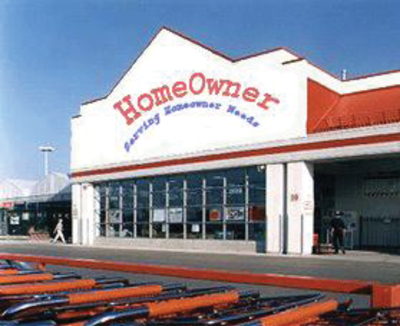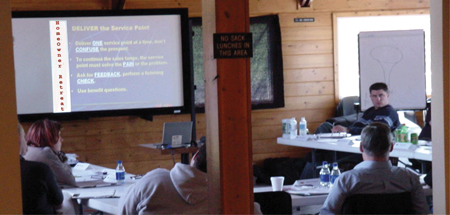Chapter 1
Birth of DigitalHome
Although home building has its ups and downs, the long-term prospects call for increases in total home square footage and intensified interest by home owners in high technology devices. New home owners, especially young professionals, are interested in living in houses that have “smart” features that automate and facilitate energy efficiency, entertainment delivery, communication, household chores, and home security. The design and construction of such dwellings relies on the latest technology (devices with smart capabilities, distributed computing, wireless and web communications, intelligent agents, etc.).

In August 202X, HomeOwner held its annual strategic planning retreat. During these one-week sessions HomeOwner officers and other upper-level managers concentrate on new initiatives that will advance the HomeOwner position as the industry leader in household product retailing.
On the first day of the 202X retreat, Dick Punch (VP of Marketing) and Judy Fielder (Chief Information Officer) made a presentation about the trend for “smart” technology and the market for building dwellings that integrate smart technology into every aspect of home living (environmental and energy control, security, communication, entertainment, household chores, etc.). Punch and Judy argued that the potential market for “smart” houses is tremendous, and although HomeOwner currently sells a number of smart home devices, it does not market the “complete package”. There are construction companies that during the planning and building phases incorporate computer and communication systems needed to combine and control the smart devices in such a way that best serves the needs and desires of today’s new tech-savvy upwardly mobile professional. Punch and Judy recommended that HomeOwner become a competitor in this field, and look for opportunities to push the industry to building “smarter” houses.

Red Sharpson, CEO of HomeOwner, loved the smart house idea and decided to devote the rest of the week to formulating plans for this new initiative. After days of discussion and debate the following decisions were made:
■ Establish a new DigitalHomeOwner Division of HomeOwner to be headed by Jose Ortiz (currently Deputy CIO).
■ Develop a two-year strategic plan for the division.
■ Assemble a staff for the division.
■ Develop a one-year division budget plan.
In the next year, DigitalHomeOwner will carry out the following activities:
■ With the assistance of the Marketing Division, DigitalHomeOwner will research the existing smart houses, and conduct a needs assessment for a DigitalHome product, which will provide the computer and communication infrastructure for managing and controlling the “smart” devices in a home to best meet the needs and desires of homeowners. In other words, building houses that take the advantage of Internet of Things (IoT) technology.
■ Choose a set of features for the DigitalHome product to develop a high-quality “proof of concept” prototype to illustrate how the DigitalHome needs will be met. Because of time constraints, the features chosen will be a subset of the actual needs. It is envisioned that this will primarily be a “software effort”, with simulation being used to represent dwelling structures, hardware devices, and communication links.
■ Jose Ortiz will form a team and supervise it in the development of the DigitalHome prototype.
■ Jose Ortiz will deliver a report on the DigitalHome efforts at the August 202Y strategic planning retreat.
■ In addition, DigitalHome will include the following special considerations:
– It is anticipated that the DigitalHome prototype will be the foundation for future development of DigitalHomeOwner products. Hence, it is essential that the development team use established software engineering practices and fully document their work.
– In development of the prototype, DigitalHomeOwner should have two primary client groups: (1) potential DigitalHome users and (2) the upper management of HomeOwner. These clients should be part of an acceptance testing process for the prototype.
– At the retreat, Judy Fielder, the CIO, also presented a proposal (HomeOwner Cloud Computing Initiative Proposal) for development of a HomeOwner cloud server. Although the decision on the cloud initiative was tabled for further study, it was recommended that the DigitalHome developers consult the guidance provided in the proposal, especially as related to the privacy and security of client communication and data.
Judy Fielder pointed out that to make this project a success it was important that the project team use the best software engineering practices. Red Sharpson stated that he had little understanding about software engineering and did not know what the “best” software engineering practices were. Judy suggested that they ask Jose Ortiz to deliver a talk on software engineering on the last day of the retreat. Red agreed.
Forming a Project Team
At the 202X Homeowner Retreat, Jose Ortiz was appointed the head of the new DigitalHomeOwner Division of HomeOwner. One of his first tasks was to form a project team. The following sections describe how the team was formed and discusses the team members’ background and experience.
Jose Ortiz was born in San Diego, CA, in 1970. He received a B.S. in electrical engineering at San Diego State University and subsequently earned an MBA at California State at Transylvania. After working at several aerospace firms in the 1990s, Jose was employed as a technical manager at a small IT start-up firm, Network Solutions, in 1999. After the firm’s IPO (Initial Public Offering) in 2000 it had tremendous growth and success. In 2010, Jose was hired by HomeOwner as its Deputy CIO.
In early September 202X, Jose began to assemble a software team to develop the DigitalHome prototype. Although Jose had outstanding management skills and excellent technical knowledge about network administration, IS evolution, and IT architectures, he had little detailed knowledge about software development and recent advancements in software engineering methods and practices.
To help him in the team formation task, Jose contacted his old friend Michel Jackson, who retired after a 30-year career in software development. As a new Stanford graduate in Computer Science in 1982, Michel started his career as embedded systems programmer for a major aerospace company. Since then Michel worked in almost every facet of the software business: as a programmer, a software architect, a software/system analyst, a quality assurance director, a project manager, and an entrepreneur. He has worked on large, custom built real-time, embedded systems, shrink-wrapped software, and major web-centric applications. Most recently, Michel headed a small company that specialized in software analysis and modeling, exploiting the use of the Jackson Analysis Framework. After selling his firm last year he has been in quasi-retirement, with part-time consulting work occupying his non-leisure time.
Michel eagerly agreed to help Jose in recruiting a DigitalHome development team. Jose and Michel conferred about the team organization for the project and agreed that the team should be organized in a quasi-democratic manner, with each member assigned prescribed responsibilities and all major decisions to be made after team discussion, with the Team Leader making the final call. Table 1.2 contains the description of the DH Team roles. All team members may be assigned responsibility for a software unit (component/unit design, coding, and testing).
Michel first contacted Disha Chandra, who he had met when he did some consulting work for SoftMedic. Disha had come to HomeOwner three years ago, after a decade of work at SoftMedic. At SoftMedic she worked in a variety of roles on the development and maintenance of a number of widely used software applications in the field of health delivery and management. Most recently, at Homeowner, Disha lead the development of an in-house application used by HomeOwner store managers to train new employees.
Disha is 38 years old and came to the U.S. from India in 2000 to work on a degree in Computer Science at Valley State University. After completing her degree, she went to work for SoftMedic, became a U.S. citizen, and earned an online Master of Software Engineering degree from Lancaster Institute of Technology. She is considered a strong leader and an effective manager with excellent knowledge and experience in almost all areas of software engineering.
Jose interviewed Disha and was very impressed with her experience, and the confident and organized way she approached her work. He offered her the job of Team Leader. She accepted with one stipulation, she wanted Michel to serve as the project’s Software Analyst. Jose and Disha conferred with Michel about the Software Analyst role and Michel was enthusiastic about working on the project and accepted the offer.
From this point, Disha and Michel worked together to form the rest of the team. In the next ten days they contacted and interviewed eight persons for the DigitalHome project. After some consideration and agreement from Jose Ortiz, the following team members were selected.
■ Yao Wang, Software Architect, DH System
Yao Wang is considered a whiz kid of object-oriented design. At 26 years of age he shows great promise to be an innovative leader in software design of embedded consumer products. He was hired by Jose Ortiz right after graduation from Rational University and is viewed as future principal player in the DigitalHomeOwner Division.
■ Georgia Magee, Quality Manager, DH System
Georgia Magee has worked for the last three years as a programmer and a test engineer at HomeOwner. Prior to that, she had a four-year stint with the Volcanic Power Company, as a junior software engineer developing electric power management software. Georgia is married, 30 years old, and recently became a mother with the birth of her first child, George.
■ Massood Zewail, Planning Manager, DH System
Massood recently graduated from the University of Central California (UCC) with a joint degree: an undergraduate degree in computer engineering and master’s degree in software engineering. Although Massood was an outstanding student (3.87 GPA) and had two summers of student intern work with MacroSoft Corporation working on two different projects which followed two different development processes (spiral and agile), this is his first full-time professional employment.
As part of the team formation, Disha, in consultation with the other members, decided that each team member would have additional responsibility as a Component Developer, developing one or more software components.
Assessing DigitalHome’s Needs
One of the key decisions at the August 202X HomeOwner retreat was for DigitalHomeOwner, with the assistance of the Marketing Division, to conduct a needs assessment for a DigitalHome product that would best meet the needs and desires of homeowners. In early September, Jose Ortiz met with Dick Punch, VP of Marketing, and they decided on a set of parameters to use in developing a Need Statement for the DigitalHome product. Dick agreed to have the Marketing Division draft two documents in the coming weeks: a DH Customer Need Statement and a DH High-Level Requirements Definition (HLRD).
DH Customer Need Statement
The Marketing Division of HomeOwner produced a draft Need Statement for DH and submitted it to Jose Ortiz for review and feedback. The Need Statement was based on research that involved structured interviews and focus groups of potential DH customers and users. The results were analyzed and assembled into statements about the needs of a fictional Wright family, who represent a set of typical potential DH users. The DH Customer Need Statement is in Appendix A.
DH High-Level Requirements Definition
After some discussion about the DH Need Statement, the Marketing Division prepared a DH High-Level Requirement Definition (HLRD). The HLRD is not meant to cover all the expectations in the Need Statement, but rather represents a subset of needs that can form the basis for a prototype development. As such, it follows the directive issued in the HomeOwner August retreat: “Choose a set of features for the DigitalHome product to develop as a prototype to illustrate how the DigitalHome needs will be met. Because of time constraints, the features chosen will be a subset of the actual needs”. The HLRD is included in the below section.